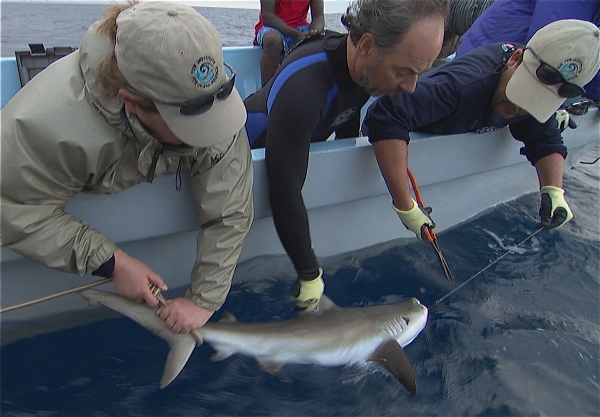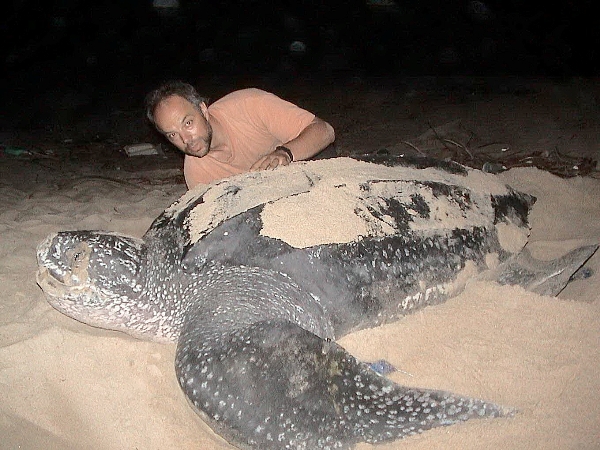PBS Show ‘Saving the Ocean’ with Carl Safina Returns to TV

Saving the Ocean host Carl Safina with a shark in Belize. (Photos via Chedd-Angier Production Company)
At first, a TV show called Saving the Ocean might bring to mind a heroic host or team of people who set out to locate and reverse threats and dangers to the sea. However, the series, which first aired October 2012 and is produced by Boston-based company Chedd-Angier, is based on stories of hope and innovation during a time when environmental news skews toward the negative. The show recently returned on PBS this past Sunday for another cycle of 10 half-hour episodes starring distinguished host Carl Safina, a notable marine biologist, writer, conversationalist, and founder of the Blue Ocean Institute.
In Sunday’s episode, titled “Shark Reef,” Safina headed to Belize where he explored Glover’s Reef Marine Reserve, where fishing longlines and nets are banned to help keep sharks within the coral reefs alive and well. Safina and a team of researchers encounter some of the nearly 800 tagged sharks in the area and show us how they are thriving. This Sunday in “The Sacred Island,” he shows how villagers on a Zanzibar island won a fight against resort developers to preserve the surrounding reefs where they fish for livelihood.
Safina, who devotes his time to exploring changes in the ocean, has authored six books and whose work has been featured in publications like National Geographic and The New York Times, answered some of our questions via email from Kenya. He talks about his beginnings in marine biology, his PBS series, and how we can ensure continued progress toward preserving the planet’s oceans.
Talk a little bit about your path to becoming the marine biologist, conservationist, writer, and researcher you are today.
I was born in a little coastal town called Brooklyn, New York. My father was a fair-weather fisherman and two uncles had a boat. That was quite enough to open the ocean to me. My father took me crabbing from the Cross Bay Bridge, fishing on boats out of Sheepshead Bay, and best were the rare opportunities to go out on my uncles’ boat, fishing for bluefish and bluefin tuna. The tuna were thrilling. Once while tuna fishing when I was a teenager, a head the size of my torso rose from the sea. It was a leatherback turtle weighing approximately 1,000 pounds, and it swam right next to the boat. I will never forget it. I also learned when I was about seven that some animals were endangered.
When I was 10 we moved to the Long Island Suburbs. Boring as can be, but I was within a bike ride of some wondrous woodlands. When the bulldozers destroyed those woods I loved, I realized the same thing had happened to make the neighborhood I lived in, and I became very concerned about conservation of nature.
What are some of the biggest issues discussed on Saving the Ocean? Are there any threats stemming largely off the coast of Massachusetts or New England?
The biggest single issue is that people are threatening the natural things that make people possible—things like clean water and adequate food. And that people are crowding other species from the farthest reaches of our planet. But the show isn’t about issues, it’s about innovation in solving these issues and finding the right relationships.
New England has destroyed what was the most productive fishing area in the world. That took centuries [to develop], but in the last 30 years, [people have] killed the last surviving members of a flock of geese that laid their golden eggs. By never having the discipline to get ahead of the problem once and for all, the fishing community has dealt itself a horrible slow death. Right now, even as catch quotas are again reduced, the plan is to open large areas off of New England that have been closed for 20 years to let fish recover. How is that supposed to help?

Safina with a leatherback turtle.
Regarding ocean conservation, what are a few ways the public, especially those who know very little about the ocean and its threats, can make little steps forward?
The biggest effect individuals have on the ocean is through the seafood we choose. Blue Ocean Institute and the Monterey Bay Aquarium have information showing which seafood is better and which is caught in ways causing harm. The second major effect is through our use of fossil fuels. So being careful about energy use and especially supporting clean-energy technology and pro-clean policies is important. Also, don’t throw things down the drain if you wouldn’t want them in your drinking water. And finally, show support for groups doing the kind of work you wish you could do. That’s how to be part of it.
What do you believe is the most important part of the Saving the Ocean series? What can we expect from the new season?
Most people have had their fill of how threatened everything is and how hopeless it seems. Our job is to show that the situation is hopeful. [We] showcase people who approach things in a positive way and make a positive difference, and show that if more people were inspired to take that approach, a lot of things would get better.
What do you believe is the best way to spark movement forward both nationally and internationally?
People need to see what’s there. Then they need to understand the importance of what’s there. We need to understand the rights of others—including, emphatically, other species—to exist and thrive. Then, having seen those things and been inspired to love them, [they need to be] moved to protect them. And having seen and learned to love the living things that belong in our world, that make our world worth living in, and that make human life healthier and more beautiful, we can see what has inspired people are doing to secure a future for all of us. And we can all seek our own personal ways to be part of that positive vision and those positive efforts. That’s my story, and I’m sticking to it.
For more information on Saving the Ocean and Carl Safina, visit pbs.org, chedd-angier.com, and carlsafina.org.

